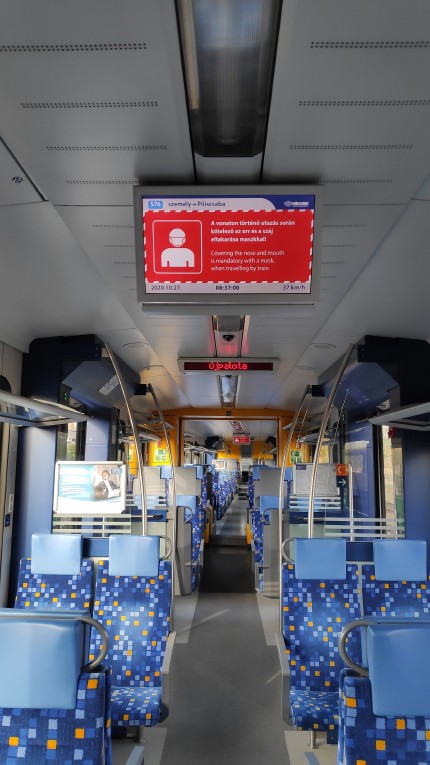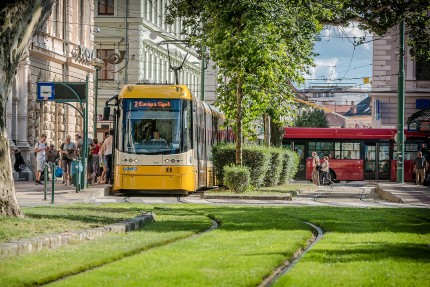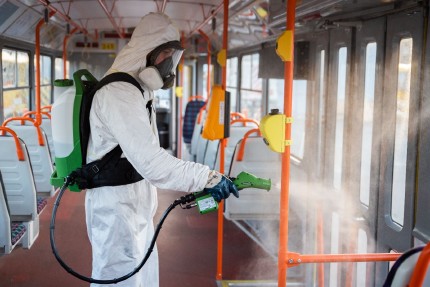Current trends and challenges in public transport
25 November 2020
Magyar CIVINET, the Hungarian-speaking regional CIVITAS network organised a joint webinar with INTERREG EfficienCE on the 19 November 2020 on „Current trends and challenges in public transport”. In the first part of the half-day event, Hungarian cities shared their experiences regarding the impacts of the second wave of COVID-19 on public transport. The second part focused on the results of the EU-funded project with presentations from the project partners about their pilots, as well as the situation in their cities, with an additional presentation from Prague.
The introductory presentation with the title “What’s next, public transport?” was held by András Ekés, managing director of Mobilissimus. Even though we got used to the new situation brought by COVID-19, new solutions and models are needed more than before. Public transport was heavily affected by the first wave of the pandemic. The ridership did not reach the previous years’ trends by the time the second wave started, and due to the profit loss and the lack of trust the operators face insecurity which is made only more difficult for them by the introduction of free parking in Hungary (effective from 4 November). The national lockdown and the mandatory increase of frequencies ordered by a government decree made immediate reaction by cities necessary, which was hard from the organizational point of view. The short-term goals in the current situation are to gain back the passegers’ trust and to secure the short-term financing, while the long-term goals include the adaptation to the changing mobility needs and to ensure the long-term financing.

Photo: Mobilissimus
According to the presentations of cities, public transport authorities and operators from Pécs, Szeged, Debrecen, Budapest and Nyíregyháza, the pandemic situation brought similar challenges and changes into the public transport of every major Hungarian city and the introduced measures were similar as well. On the one hand, the loss of passengers and its fluctuation showed similar trends, and the subsequent loss of revenues was also similar in scale. The ridership reached only 80% of the same period of last year by the end of the summer, and started decreasing again with the beginning of the second wave – with different pace in different cities. Every operator pays attention to keep the hygienic standards by distributing masks and disinfectants to their employees and checking on the mandatory mask use of passengers as well.

Photo: City of Szeged, Iványi Aurél
After the coffee break, Antal Gertheis – managing director of Mobilissimus – presented shortly the INTERREG EfficienCE project. The aim of the EU-funded project is to reduce the carbon footprint of the Central Europe region through increasing energy efficiency and the use of renewables in public transport. 12 partners are working together from 7 Central and Eastern European countries including cities, public transport authorities and operators, universities and consultancies. In addition to other project results - including capacity building, toolkits and a handbook – the project runs four pilots:
- Vienna (Wiener Linien): Implementation of photovoltaic integration at a metro station
- Pilsen (PMDP): Integrating buffer storage into the trolleybus network
- Municipality of Maribor: Upgrade of an existing cable car substation and integration of an e-bus fast charger
- Gdynia (PKT): Using recuperated braking energy and renewable energy sources to power the trolley depot
In his first presentation, Dominik Reiterer from Wiener Linien talked about their pilot project. Renewable energy is very important from the climate change perspective; therefore, the company would like to produce clean energy. They measured the potential metro roofs in Vienna from the point of view of solar panels, and it was as big as 100.000 m2. They planned the solar panel system a year ago and they already implemented it at one of the stations. At this point they are in the phase of monitoring. This solution was not feasible before because of the weight of the panels and the stray current. Now they are testing an innovative solution which is lighter and has no earthing system, so the problem of stray current is resolved. Early indications showed that half of the energy needed to run the Ottakring underground station comes from solar power around midday.
In his second presentation he talked about the situation caused by the pandemic. Wiener Linien is Austria’s largest local public transport provider operating bus, tram, and underground lines. The ridership was gradually increasing during the past years; this trend was hit by the first wave of the pandemic. The main goal was to keep the city moving: they prepared several communication materials and while they were trying to protect their employees, they also wanted to maintain the trust of the citizens. Therefore, they introduced all the necessary hygienic measures, and adapted their schedule to the needs and new regulations: the supply always exceeded the demands by 50 percent to have enough space between the passengers.
Photo: Vienna, Mobilissimus
The situation in Pilsen was presented by Jiří Kohout from the Pilsen City Public Transport Company (PMDP). In his first speech, he talked about how the second wave affected this industrial city with a population of 170.000. The company’s focus since Autumn is to disinfect the vehicles. After having tested several techniques and methods during the first wave, the conclusion was that the special technology is too expensive and not comparably effective; therefore, they use deep cleaning on a daily basis. The city’s public transport is affected negatively as well, but luckily there are no government messages discouraging public transport use. Apart from the loss in ridership, another significant problem is the traffic: the buses and trolleybuses cannot keep the schedule because of the increased car traffic. PMDP also tries to gain back the passengers’ trust, e.g. by promoting the material published by UITP, according to which using public transport is not dangerous if the vehicle is not crowded and everyone is wearing masks (correctly). While during the first wave ridership was below 30 percent compared to the previous year, during the summer it became somewhat close to the usual summer figures and it was restored by September to 90 percent. Since then, it decreases again. The automatic passenger counting system helps them in continuously adapting to the demand.
Energy efficiency is very important for the company: two third of the public transport in Pilsen is already electric. The “Pilsen smart city goal” is to increase the ratio to 85 percent by 2030 and it is supported by tangible ideas. One is to complete public transport with battery buffer storage stations in order to balance the peak load and therefore increase energy efficiency; this is an innovative tool which was implemented within the EfficienCE project. Another one is a test line served by battery trolleybuses (line 19) which was operated in Pilsen between the 2 December 2019 and 26 June 2020. The pilots are still being tested and evaluated.

Photo: Pilsen, PMDP
The last presentation was held by Jiří Došlý from DPP, the public transport operator of Prague. Prior to the pandemic, public transport made up 59 percent of mobility in the city, equalling to 1.2 billion passengers yearly. The company has 11.000 employees and operates underground, tram, bus, trolleybus, cable car and funicular. The ridership dropped during the first wave; in April they lost half of their revenues. Before the second wave, it was restored to around 80 percent compared to last year, but – unfortunately – due to the postponed introduction of restrictions, the Czech Republic is one of the worst affected countries. Currently, the ridership on the underground is around 36 percent. Since public transport is key for cities, DPP aims to go back to the pre-COVID-19 situation. However, politicians rather promote bikes and cars as means for transport which latter has a negative impact. In the coming weeks a coordinated campaign titled “COVID-safe public transport” will be launched in the Czech Republic.
Photo: Prague, DPP
